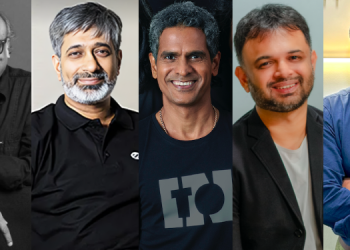Facial recognition has found another application. With Google’s Project GameFace, one can engage in gaming without the use of one’s hands. It detects facial gestures and head movements and translates them into cursor movements on a computer.
Google Gameface was inspired by the story of quadriplegic video game streamer Lance Carr (pictured). Gesture-Controlled Gaming (GCG) makes gaming more inclusive. But could it be the future mode of gaming?
What could be the impact of Project Gameface on gaming? Is gesture-controlled gaming (GCG) the future? Are there gesture-controlled alternatives to Gameface?

Lokesh Suji, Director, Esports Federation of India & Vice President of the Asian Esports Federation (AESF), notes, “With the influx of new technologies taking the e-sports industry by storm, the impact of Project Gameface on the sector could be quite significant. By providing players with a hands-free and intuitive control system, it introduces a new way of interacting and engaging with games for anyone and everyone. Gesture-controlled gaming has the potential to revolutionise the gaming experience as it offers enhanced immersion experience and accessibility for players and Supergaming integrating it into their upcoming game Indus is a testament to it. While it may not replace traditional video gaming methods entirely, GCG can surely provide an additional layer of interactivity and innovation to gaming.”
“Currently, Project Gameface seems to be a unique offering in the market and while there might be other gesture-controlled alternatives available, Gameface’s open-source nature and integration with Google’s technology make it a promising choice,” he adds.

Rohit Agarwal, Founder & Director, Alpha Zegus, says, “Gaming is a form of sport/entertainment where a user performs multiple different tasks and decision-making at a time – be it using keyboard/mouse/controllers to move your character or perform actions, or getting audio-visual response for movement. While GCG is a great concept, I strongly feel it’s going to be quite difficult to implement GC mechanism in most of the popular gaming titles – examples being the likes of PUBG, DotA, Valorant, etc. In these games, there are two critical issues. Firstly, a gamer performing multiple tasks is going to find it difficult to manage his/her expressions. And secondly, a game having too many emotions attached to its gameplay (rage, joy etc.) is going to make it very difficult to use expressions to perform actions. There are prototypes in the market for GC experience, but none for GCG in particular.”

Project Gameface has the potential to revolutionise the gaming industry by offering a new way to play games, especially for those who might not be able to use traditional controllers, notes Vyas Devam K., Vice President – Esports, Gods Reign.
He explains, “Gesture-controlled gaming (GCG) is definitely the future as it opens up new possibilities for game developers to create more immersive gaming experiences. There are other gesture-controlled alternatives to Project Gameface, such as Microsoft’s Kinect and Leap Motion. However, Project Gameface is unique in that it uses facial gestures to control the mouse cursor, which is a new and innovative approach to gesture-controlled gaming.”

While gesture-based controls have been around for some time, Gameface is probably the first one developed with gaming in mind, observes Abhimanyu Singh, Head of Game Production, Gamezop.
“Most of us take our capability of interacting with our surroundings for granted, but a large section of people with disabilities are deprived of these simple pleasures of life. Gameface has the potential to unlock interactive entertainment to such people, and hyper-casual games, like the ones we create at Gamezop, are one of Gameface’s best use cases. These games have extremely simplified controls and can be picked up with relative ease, making them accessible to virtually anyone. A variety of health benefits of gaming like social interaction, improved cognitive and coordination skills as well as stress reduction, were difficult to access for disabled people earlier. Gameface provides the possibility of changing that now,” explains Singh.
Will Gamers Miss Touch & Feel?
As with any new development, GCG and Gameface offer immense possibilities and bring with more questions than answers around those possibilities.
While Project GameFace is set to make gaming more inclusive, does it lack the touch and feel? Does it lend itself better to certain genres of games? How will it take off globally and in India?
Suji believes that GCG is an emerging technology and it is still in the process of gaining widespread adoption.
He says, “Initially, GCG may be more suitable for video gaming in specific genres that require less emphasis on fast and precise inputs but as GCG technology advances, there is potential for it to be utilised effectively in competitive gaming, including first-person shooter games.GCG may not provide the same experience as traditional input methods but it offers a different kind of interaction that can be equally engaging and immersive. It must place its emphasis on delivering a seamless and reliable experience across all games accurately. Game developers should also optimise their games for GCG. GCG will need time to gain traction but it has the potential to find a dedicated audience both globally and in India.”
Agarwal reiterates that GCG might work for casual or open world games, where there is no need to perform multiple tasks or make multiple decisions at a time, but is less likely to work in titles that warrant swift movements and awareness.
“While GC is a great concept for day to day activities, or to consume other forms of content/entertainment, gaming might be difficult on existing titles. There might be a need to develop new gaming titles to use this tech, similar to games that were developed specifically for VR,” he adds.
Devam too believes GCG can lend itself better to certain kinds/genres of games, such as puzzle games or strategy games. However, it ultimately depends on the implementation of the technology and the game design itself, he reminds us.
“Game developers will need to consider the limitations of gesture-controlled gaming and design games that work well with the technology. While it’s true that GCG doesn’t give the same tactile experience as traditional gaming controllers, it offers a new and innovative way to play games that can be more accessible for some players. I believe that GCG will take off globally and in India as people become more interested in exploring new ways to play games. As with any new technology, it will take some time for it to become more widely adopted, but I think that the potential benefits of GCG will make it an attractive option for many gamers,” he surmises.
Feedback: Editorial@medianews4u.com.

















